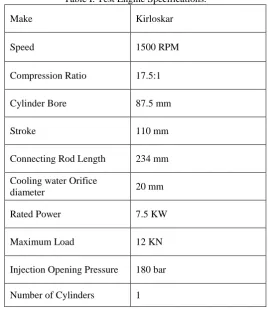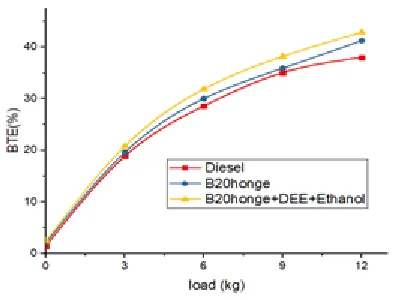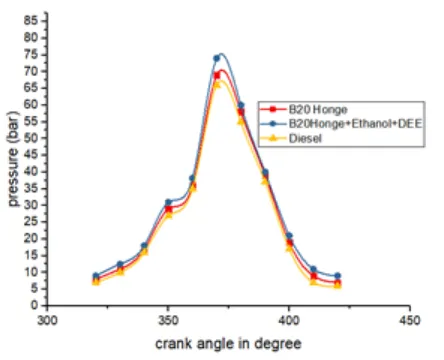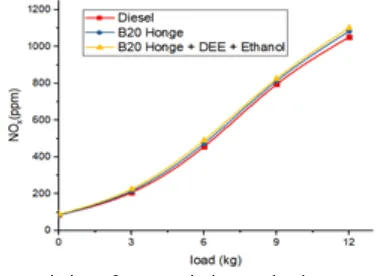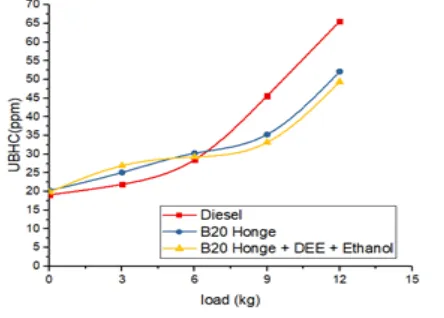Experimental Investigation of Performance,
Combustion And Emissions of CI Engine Using
Di-Ethyl Ether Additive with Honge Bio Diesel
Ramesh D K, Deepak Kumar T, Ranganath C, Sangamesh K, Pavan Kumar J, Rakshith K P
Department of Mechanical Engineering..University Visvesvaraya College of Engineering. Bangalore, India.
dkramesha@bub.ernet.in
Abstract-Demand for fuel and the use of petroleum products are increasing day by day which causes serious problems such as petroleum depletion, environment degradation etc. So biodiesel is a good alternative for conventional diesel fuel. By using biodiesel there are also some disadvantages such as high oxides of nitrogen, high fuel consumption and higher density. Additives play an important role in enhancing the properties of biodiesel .In this context, oxygenated additives like Diethyl ether (DEE) and Ethanol are rich in oxygen content. DEE possess different properties altogether with higher cetane number and lesser autoignition temperature etc, may show the way for smoother start of combustion at lower atmospheric temperature also. In this paper DEE and Ethanol are blended with the B20 Honge and tested at different loads on DI diesel engine. Emission levels are decreased substantially with DEE and Ethanol blended with B20 Honge as compared with diesel at higher loads. The thermal efficiency will increase and specific fuel consumption is better in case of oxygenated additive blend. Both additives improve combustion characteristics and also reduce the emissions of unburnt hydrocarbons (UBHC).
Keywords—CI Engine, emission, B20 Honge, Diethyl ether, Ethanol.
1. INTRODUCTION
` India is now the world’s third largest importer of crude oil after the United States and China. India’s import dependence is rising fast and it will be one of the largest sources of demand growth for the foreseeable future. Petroleum remains the largest source of energy, but its share of world marketed energy declines from 33% in 2015 to 31% in 2040. On a worldwide basis, liquids consumption increases in the industrial and transportation sectors, and declines in the electric power sector [1].
Environmental pollution is caused by conventional fossil fuels while their demand is ever increasing. So this requires more attention on alternate fuels such as biodiesel and ethanol-biodiesel blends. Both ethanol-biodiesel and ethanol can be synthesized from feedstock which is a renewable production of biodiesel using vegetable/animal oil with a short- chain alcohol like methanol or maintained below the normal boiling point methanol(65oC). Methanol as the potential to reduce both NOx and particulate matter (PM) due to
its high oxygen content and high latent heat of evaporation. Using methanol containing additives, there was a slightly decrease in PM and NOx but
where as general increase in both UHC and CO emissions. However, some of the disadvantages using methanol-diesel blends have been observed: it has reduction in viscosity, lubricity, cetane number and ignitability [2-3].
Ethanol can be easily converted into diethyl ether (DEE) by dehydration process. DEE is an excellent compression-ignition fuel with higher energy density than ethanol. It is widely known as a cold-start aid for engines. Alternatively DEE has a higher cetane number compared to the diesel fuel and higher calorific value compared to ethanol [5].
A. Transesterification
[4] .The main objective of this process is to reduce the viscosity of the biodiesel, as it cannot be directly mixed with the Diesel as they do not form homogenous mixture on blending.
In this mechanism, as shown in fig-1, the carbonyl carbon of the starting ester (RCCOR1) undergoes
nucleophilic attack by the incoming alkoxide (R2
O-) to give away a tetrahedral intermediate ,which reverts to starting material or proceeds to the transesterified product (RCOOR2) [6].
Fig-1: Transesterification
This can be achieved by mixing methanol with NaOH(sodium hydroxide 1% by weight) to make sodium methoxide. this mixture is gradually added to the honge oil when the temperature of honge oil reaches 75 degrees, the mixture was stirred continuously for few minutes and then 1% by volume of H2SO4 (Sulphuric acid) .The mixture
was allowed to settle down for 24 h, so that all the the glycerol settles down and biodiesel floats above it.
2. EXPERIMENTAL SETUP FOR ENGINE TESTING These signals are interfaced to control panel which is connected to a digital computer through engine indicator for diagrams.
The computerized test engine was used to record the various parameters such as air flow rate, temperature, fuel flow rate, etc .and for calculating the different performance characteristics such as brake thermal efficiency, brake specific fuel consumption, volumetric efficiency etc. Determination of viscosity, calorific value, density, flash point and fire point are carried out using redwood viscometer, Bomb calorimeter, Pensky apparatus. These values are fed to computerized
engine software to calculate various performance factors. Similarly combustion characteristics such as heat release rate, peak pressure were also calculated.
The exhaust gas analyzer is used to find Oxides of nitrogen, Carbon monoxide and Unburnt hydrocarbon emissions in the exhaust. These instruments were used to compute the black smoke emission using extinction of a light beam by scattering and absorption. Opacity is also a measuring extinction of light between light sources and receiver and this is calculated in terms of percentage. The specifications of engine are tabulated in Table 1.
with 20% of honge oil, diesel blended with 20% of honge oil, DEE and ethanol. This was done in order to get favorable results without over stressing the engine. The engine is initially made to run at
1500rpm continuously for one hour in order to achieve the thermal equilibrium under operating conditions.
Table I. Test Engine Specifications.
Make Kirloskar
Speed 1500 RPM
Compression Ratio 17.5:1
Cylinder Bore 87.5 mm
Stroke 110 mm
Connecting Rod Length 234 mm
Cooling water Orifice
diameter 20 mm
Rated Power 7.5 KW
Maximum Load 12 KN
Injection Opening Pressure 180 bar
Number of Cylinders 1
Table Ii. Properties Of Fuel And Blends.
Properties Diesel
Pongamia oil (Honge)
HOME DEE
Density (kg/m3)
at 400C 828 915 873 713
Kinematic Viscosity (centistokes) at
400C
3.78 42.78 5.546 0.23
Specific gravity
(at 400C) 0.828 0.909 0.873 0.713
Calorific value
3. RESULTS AND DISCUSSION
A) Performance characteristics.
1) Brake Thermal Efficiency:
Figure 2 depicts the comparison of brake thermal efficiency of Diesel and Honge Biodiesel blends at various loads. The graph exhibits that the brake thermal efficiency of Honge biodiesel blend (B20 Honge + DEE + Ethanol) is higher than that of Diesel at various loads. It can be observed from the graph that at low loads all the fuel blends deliver same thermal efficiencies[7]. The validation for the Honge biodiesel blend (B20 Honge + DEE+
Ethanol) showing higher brake thermal efficiency is due to the high oxygen content in the blends of Honge as ethanol and DEE consists of high oxygen content which readily helps in combustion of hydrocarbons[11]. During specific injection timing as the load increases there is a linear increment in the Brake thermal efficiency and this happens due to increase in fuel conversion efficiency and better Oxygen – fuel ratios at high load. Thus this attributes to the increase in the combustion efficiency of the biodiesel. The average Brake thermal efficiency obtained is 36%.
Fig. 2. Variation of break thermal efficiency vs load.
2) Specific Fuel Consumption:
Figure 3 depicts the Brake specific fuel consumption of Diesel and Honge biodiesel blends at various loads. The characterization is that as load increases BSFC decreases and it is referred from the figure 3 that the BSFC of biodiesel blend (B20Honge+DEE+Ethanol) is more compared to that of Diesel at initial loads but it tends to be similar at higher loads due to the addition of oxygenated additives like DEE and Ethanol as they
are more volatile which boosts up the mixing velocity of fuel air mixture and results in good combustion process and they /exhibit marginal variation as load increases. The endorsement for the increase in BSFC of biodiesel blend (B20Honge+DEE+Ethanol) compared to Diesel is as Biodiesel has lower calorific value and higher viscosity which in turn produces less heat energy compared to Diesel and produces same energy output with more mass of fuel consumed.[7-9].
B) Combustion Characteristics. 1) Heat release rate:
Figure 4 depicts the variation of heat release rate of the Biodiesel blends and Diesel at maximum loading conditions which nearly occurs near to the TDC (Top dead centre). The maximum heat release increases with addition of DEE and Ethanol concentration, which is seen at the end of compression at TDC [10]. DEE and Ethanol act as Oxygenator and improves the overall combustion for all fuel
blends. The laminar flame propagation speed of Ethanol and DEE results in high heat release rates compared to that of Diesel. It can also be observed that the negative depression of the curve in the cycle which is during the ignition dela period and it occurs due to the loss of heat from the c linder during the vapori ation phase of the fuel and poor cetane value of thanol The peak heat release rate observed from the graph is 86 J
Fig. 4.Variation of HRR versus crank angle(θ)
2) Cylindrical peak pressure:
Figure 5 depicts the variation of pressure in the combustion chamber at the various crank angles. It was found that the cylindrical peak pressure was increased at all load levels from 6 to 11 bars with blended fuel as compared to diesel. The validation for the increase in pressure is due to the improved
combustion of fuel and the presence of oxygen in the fuel particle enhances the low temperature reaction in proper direction[12].The maximum increase in pressure from 6 to 11 bars is for B20 Honge +Ethanol +DEE.
C) Emission Characteristics. 1) Carbon monoxide emissions:
Carbon monoxide (CO) is one of the fatal pollutant greenhouse gas and highly toxic.Figure 6depicts the emission of carbon monoxide of fuels tested with various loads. It is observed that the variation in CO emissions for all biodiesel blends and diesel is quite similar. It is also identified that Diesel emits more CO due to incomplete combustion of carbon. This may be due to the oxygen content and less C/H ratio of biodiesel that causes complete combustion. The biodiesel contains more oxygen which easily converts CO to CO2. The CO
emissions can be reduced by increasing oxygen percentage in charge. Initially the air fuel composition is a lean mixture hence the CO emissions are high but at half load the air fuel mixture ratios are optimum hence the CO readily converts into CO2 but at high loads the air fuel
ratios are of rich mixtures which results in improper combustion and leads to increase in co emissions.
Fig. 6.Variation of Carbon monoxide vs load. \
2) NOx emissions:
The figure 7 depicts the variation of NO x
emissions of Honge blends and Diesel over various loads. The NO x emissions for Biodiesel (Honge
B20 + DEE + Ethanol) is higher compared to Diesel, as the lower heat release rate of Diesel due to lower combustion temperatures. As the Biodiesel blends (Honge B20 + DEE + Ethanol) contain high Oxygen the nitrogen does not readily react with oxygen at lower combustion temperatures, at
higher temperatures they react partially with Oxygen to produce Nitrogen oxides. This is due to the presence of antipenultimate shells of Nitrogen they tend to behave inert. NOx emissions for Diesel were relatively lower for all Start of ignition timings compared to Biodiesel blends. NOx emission of B20 biodiesel is found to decrease marginally as compared to Diesel. Due to higher HRR the in cylinder temperature would also increase thereby NOx emissions will be more[11].
3) UBHC emissions:
Figure 8 exhibits the UBHC emissions with various loads applied. It is noticed that the UBHC variation is significantly varying for Biodiesel blend (B20Honge+DEE+Ethanol) with addition of Oxygenated additives. As load increases the emissions of the biodiesel blends at initial loads were quite more compared to Diesel due to less volatility and low temperatures. At higher loads the Biodiesel blends exhibited less emission compared to Diesel due to the presence of oxygen in biodiesel
and higher combustion temperature, which promotes the oxidation of hydrocarbon emissions. The reason for this behaviour of diesel is because it is highly volatile compared to biodiesel which
Fig 8. Variation of UBHC emission vs load
4.CONCLUSION
Based on the analysis of different blends of diesel with honge oil the following conclusions have been drawn:
• The oxygenated additives such as DEE and Ethanol improved atomization, combustion and showed better emission characteristics through higher engine brake power, lower BSFC and higher BTE.
• Diethyl ether showed the improvement through its density, viscosity properties and high calorific value but ethanol showed less development because of less calorific value and poor cetane number.
• Decrease in CO and UHC emissions due to the higher oxygen content and NO decreased for high latent heat of evaporation .
• At half load, emission of CO is reduced in the blend containing B20 Honge+DEE+Ethanol compare to pure diesel.
• We can conclude that oxygenated additives are very important for biodiesel and also continuous encouragement and for providing engine research facility.
REFERENCES
[1] EIA ,International energy outlook, 2017. [2] C.S. Cheung, Lei Zhu, Zhen Haung.
―Regulated and unregulated emissions from a diesel engine fueled with biodiesel and biodiesel blended with methanol‖ Atmospheric environment 43(2009) pp:4867-4871
[3] Pt Williams ‖Fluidised bed p rol sis of low density polythene to produce petrochemical feed stock‖
[4] Md. Hasan ali, Mohammad mashud, Md. Rowsonozzaman Rubel, Rakibul Hossain hmad ―Biodiesel from neem oil as an alternative fuel for diesel engine‖ Procedia engineering 56 (2013) pp:626-629.
K ritsis ―Influence of properties of various common bio-fuels on the combustion and emission characteristics o high- speed DI diesel engine‖ nerg 73 (2014) pp:356-359. [6] Jayashri N. Nair. Ajay Kumar Kaviti, Arun
Kumar Daram ‖ nal sis of performance and emission on compression ignition engine fuelled with blends of Neem biodiesel‖ Egyptian journal of petroleum (2017) 26,pp:927-930.
[7] D K Ramesha G, Prema Kumara, Lalsaheb’ Aamir V. T.Mohammed, Haseeg A. Mohammad, Mufteeb in Kasma ― n experimental study on usage of plastic oil and B20 algae biodiesel blend as substitute fuel to diesel engine‖ Pollution control technologies and alternate energy options,accepted 14 December 2015.
[8] M. Mofijur, A. E. Atabani, H. H. Masjuki. M. Kalam, B M Masum ‖ stud on the effects of promising edible and non-edible biodiesel feedstocks on engine performance and emission production‖: omparative evaluation. Renewable and Sustainable Energy Reviews 23 (2013) pp:393-396.
[9] Raghavendra Prasada S. A, K V Suresh, Pongamia Pinnata (karanja) ―Biodiesel as an alternative fuel for diesel engine‖ ISSN 2320_3927, accepted 03 November 2014. [10]K Sivaramakrishnan,‖ Investigation on
performance and emission characteristics of a variable compression multifuel engine fuelled with karanja biodiesel-diesel blend‖ g ptian journal of petroleum. (2017)pp:6-9.
[11]K. Anubumani and Ajit Pal Singh ‖Performance of mustard and neem oil blends with diesel fuel in I ngine‖ 2006-2010 Asian Research Publishing Netwotk,pp:16-17
[12]Banapurmath NR,Khandal
